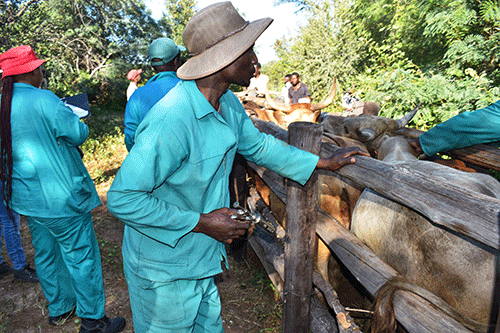THE Directorate of Veterinary Services and the Food and Agriculture Organization of the United Nations (FAO) will continue their joint efforts to tackle crucial animal health issues across Namibia’s northern communal areas (NCAs).
The two entities, in collaboration with the agriculture ministry, will spearhead a vaccination campaign targeting the most common and potentially devastating animal health diseases affecting livestock in Namibia, including Contagious Bovine Pleuropneumonia (CBPP), Foot-and-Mouth Disease (FMD), and Anthrax.
FAO, in assisting the veterinary services with detecting, preventing and containing all animal health diseases in the NCA, donated a vehicle to enhance the veterinary services mobility and effectiveness in reaching remote areas and also donated vaccination and camping equipment.
Recently, FAO officials visited Musu in the Nkurenkuru constituency, Kavango West region, to witness first-hand the vaccination of livestock brought by farmers from Musu and surrounding areas.
The vaccination campaign prioritises protecting livestock in the NCA, a vital source of income, food security, and livelihood for many Namibian communities. The joint efforts between FAO and the Veterinary Services aims to reach across all areas north of the veterinary cordon fence.
FAO’s National Project Coordinator Eugene Kanguatjivi said: “This animal vaccination campaign is a vital step towards safeguarding Namibia’s livestock population and protecting the livelihoods of our farmers. FAO is proud to partner the DVS in this crucial effort, ensuring the health and productivity of animals across the northern communal areas.”
Meanwhile, state veterinarian Dr Paul Set acknowledged that “the support from FAO, particularly the vehicle and vaccination equipment, has significantly boosted our capacity to reach more farmers and animals in remote areas. This collaborative vaccination campaign is essential for controlling major diseases and strengthening Namibia’s animal health system.”
Last year, the veterinary services organised training for livestock farmers in the northern regions of Zambezi, Kavango East, Kavango West, Oshikoto, Ohangwena, Oshana, Omusati, and Kunene regions.
Through the trainings, the Veterinary Services puts special focus on teaching farmers how to recognise clinical signs of diseases such as FMD, CBPP, rabies, and PPR, among others.
Farmers are also encouraged to promptly report any disease incidences to nearby veterinary offices for thorough investigation and surveillance. This proactive approach aims to strengthen the early warning and response system for better disease control.
Through the empowerment of farmers with knowledge and the promotion of proactive measures, the initiative contributes to the overall welfare of livestock, ensures food security, and safeguards public health by mitigating the transmission of zoonotic diseases.
Namibia’s NCAs are home to more than one million cattle and 860 000 sheep and goats.
-ohembapu@nepc.com.na


